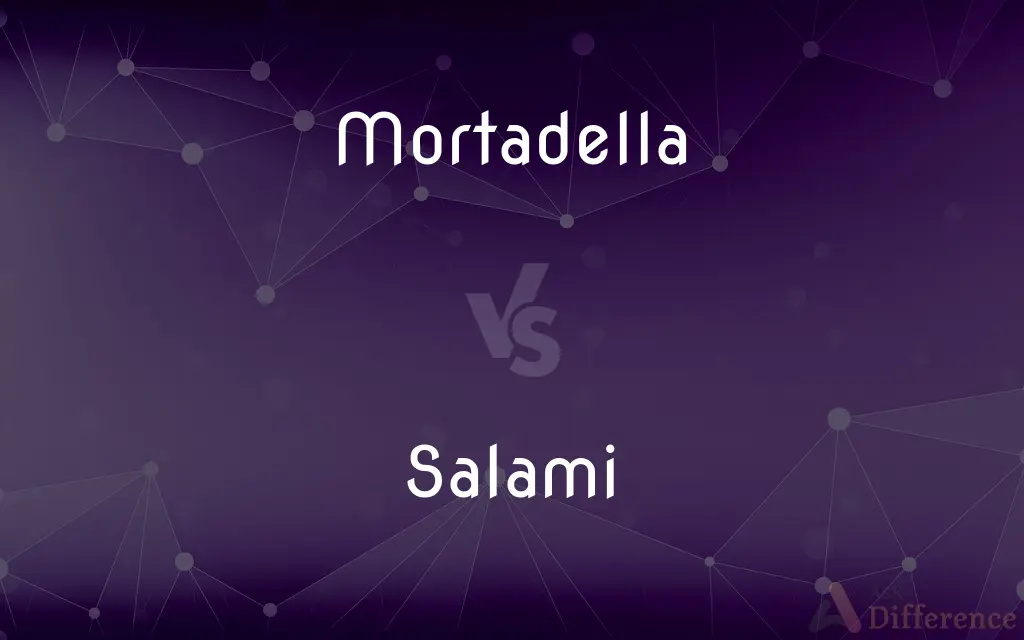Mortadella vs. Salami — What's the Difference?
Edited by Tayyaba Rehman — By Urooj Arif — Updated on April 26, 2024
Mortadella is a large Italian sausage known for its smooth texture and inclusion of pistachios and fat cubes, while salami is a cured sausage characterized by a fermented and air-dried process, typically seasoned with garlic and pepper.

Difference Between Mortadella and Salami
Table of Contents
ADVERTISEMENT
Key Differences
Mortadella is a traditional Italian sausage that originates from Bologna, Italy. It is known for its smooth texture and distinctive pink color, whereas salami is a more general category of cured sausage that encompasses a variety of types from different regions, often with a more coarse texture.
Mortadella typically includes small cubes of pork fat, along with spices and sometimes pistachios or myrtle berries, giving it a unique flavor profile. On the other hand, salami is usually made from a mixture of pork and other meats like beef, and is heavily seasoned with garlic, salt, and pepper, often incorporating wine or vinegar for added flavor.
The production process of mortadella involves grinding the meat into a fine paste, stuffing it into a large casing, and then cooking it thoroughly. In contrast, salami is fermented and air-dried, which contributes to its firmer texture and tangier flavor due to the curing process.
Mortadella is often served sliced very thin and eaten as part of antipasti platters or in sandwiches, highlighting its delicate flavor and soft texture. Salami, meanwhile, is more versatile in its use, being suitable for sandwiches, pizza toppings, and as a robust component of charcuterie boards.
In terms of geographical popularity, mortadella is primarily consumed and associated with its region of origin in Italy, while salami enjoys widespread popularity across various cuisines globally, reflecting a broader cultural integration.
ADVERTISEMENT
Comparison Chart
Origin
Bologna, Italy
Various regions, originally Italy
Texture
Smooth and fine
Coarse and firmer
Ingredients
Pork, pork fat, pistachios
Pork, beef, garlic, salt, pepper
Preparation Process
Ground, stuffed, and cooked
Fermented and air-dried
Typical Uses
Antipasti, sandwiches
Sandwiches, pizzas, charcuterie
Compare with Definitions
Mortadella
A cured meat product originating from Bologna, known for its delicate flavor and pink color.
Mortadella is often compared to bologna but is richer and more flavorful.
Salami
Often used in sandwiches, diced in salads, or served as part of a charcuterie board.
She added chunks of salami to the pasta salad for extra flavor.
Mortadella
Recognizable by its large diameter and dotted appearance from fat cubes.
The mortadella looked festive with its green pistachios and white fat cubes.
Salami
A type of cured sausage consisting of fermented and air-dried meat.
He sliced the salami thinly for the pizza topping.
Mortadella
A large Italian sausage made from finely ground pork and cubes of fat, often containing pistachios.
The deli offered a freshly sliced mortadella that was exceptionally creamy and rich.
Salami
Known for its robust flavor and dense texture, ideal for hearty dishes.
The robust flavor of the salami pairs well with strong cheeses.
Mortadella
Typically eaten cold, sliced thinly in sandwiches or as part of an appetizer platter.
She arranged slices of mortadella with olives and cheese for the guests.
Salami
Commonly made from a mixture of meats and seasoned with a variety of spices.
The salami on the charcuterie board had a noticeable hint of garlic.
Mortadella
Considered a delicacy in Italian cuisine, often associated with gourmet food items.
For our Italian dinner night, we must get some mortadella from the specialty store.
Salami
Salami varieties vary widely depending on the region and specific recipes used.
On their trip to Italy, they tried several different types of regional salami.
Mortadella
Mortadella (Italian pronunciation: [mortaˈdɛlla]) is a large Italian sausage or luncheon meat (salume [saˈluːme]) made of finely hashed or ground heat-cured pork, which incorporates at least 15% small cubes of pork fat (principally the hard fat from the neck of the pig). It is traditionally flavoured with black pepper grains, but modern versions can also contain pistachios or, more rarely, myrtle berries.
Salami
Salami ( sə-LAH-mee) is a cured sausage consisting of fermented and air-dried meat, typically pork. Historically, salami was popular among Southern, Eastern, and Central European peasants because it can be stored at room temperature for up to 40 days once cut, supplementing a potentially meager or inconsistent supply of fresh meat.
Mortadella
A heat-cured Italian sausage usually made of ground pork and cubes of pork fat and flavored with wine and spices.
Salami
Any of various highly spiced and salted sausages, made from beef or a mixture of pork and beef.
Mortadella
A smooth-textured Italian pork sausage with lumps of fat, flavoured with spices; eaten cold.
Salami
A large cured meat sausage of Italian origin, served in slices.
Salami
Highly seasoned fatty sausage of pork and beef usually dried
Common Curiosities
Are there different types of salami?
Yes, there are many types of salami, each varying by region and ingredients, including Genoa salami, soppressata, and chorizo.
How long can you store salami?
Salami can be stored for several months in a refrigerator, thanks to its curing process which helps preserve the meat.
What type of meat is used in mortadella?
Mortadella is primarily made from high-quality pork, though some varieties may include beef or other meats.
Is mortadella or salami better for cooking?
Salami is more commonly used in cooked dishes like pizza due to its texture and flavor, which holds up well under heat.
Are there any health benefits to eating mortadella?
Mortadella is rich in protein and B vitamins, although it should be consumed in moderation due to its high fat and sodium content.
Can mortadella be used as a pizza topping like salami?
While less common, mortadella can be sliced and added to pizza, particularly in gourmet or artisan preparations.
What is the nutritional value of salami versus mortadella?
Both are high in proteins and fats, but salami generally has a higher calorie count due to its dense, meaty composition.
Why does mortadella have pistachios?
Pistachios are added to mortadella for flavor and to enhance its visual appeal with green specks against the pink meat.
Does mortadella contain any allergens?
Mortadella may contain allergens such as nuts (pistachios) and dairy, depending on the variety.
How is the texture of mortadella different from that of salami?
Mortadella has a very smooth and soft texture, ideal for slicing thinly, while salami is firmer and more suitable for chopping or dicing.
How should salami be stored to maintain its best quality?
Salami should be wrapped in paper or a breathable cloth and kept in a cool, dry place or refrigerated.
What are the best ways to serve mortadella?
Mortadella is best served thinly sliced, either alone or as part of an appetizer platter, complemented by cheeses and olives.
Why is salami often more expensive than mortadella?
The lengthy curing process and the quality of ingredients can make salami more costly compared to the more straightforward production of mortadella.
What spices are typically used in salami?
Common spices in salami include garlic, black pepper, and sometimes fennel or chili flakes, depending on the variety.
Can both mortadella and salami be eaten raw?
Yes, both are cured meats that are safe to consume without cooking; however, they are usually eaten as is, especially in platters and sandwiches.
Share Your Discovery

Previous Comparison
Thesis vs. Antithesis
Next Comparison
Boiling vs. SimmeringAuthor Spotlight
Written by
Urooj ArifUrooj is a skilled content writer at Ask Difference, known for her exceptional ability to simplify complex topics into engaging and informative content. With a passion for research and a flair for clear, concise writing, she consistently delivers articles that resonate with our diverse audience.
Edited by
Tayyaba RehmanTayyaba Rehman is a distinguished writer, currently serving as a primary contributor to askdifference.com. As a researcher in semantics and etymology, Tayyaba's passion for the complexity of languages and their distinctions has found a perfect home on the platform. Tayyaba delves into the intricacies of language, distinguishing between commonly confused words and phrases, thereby providing clarity for readers worldwide.
















































